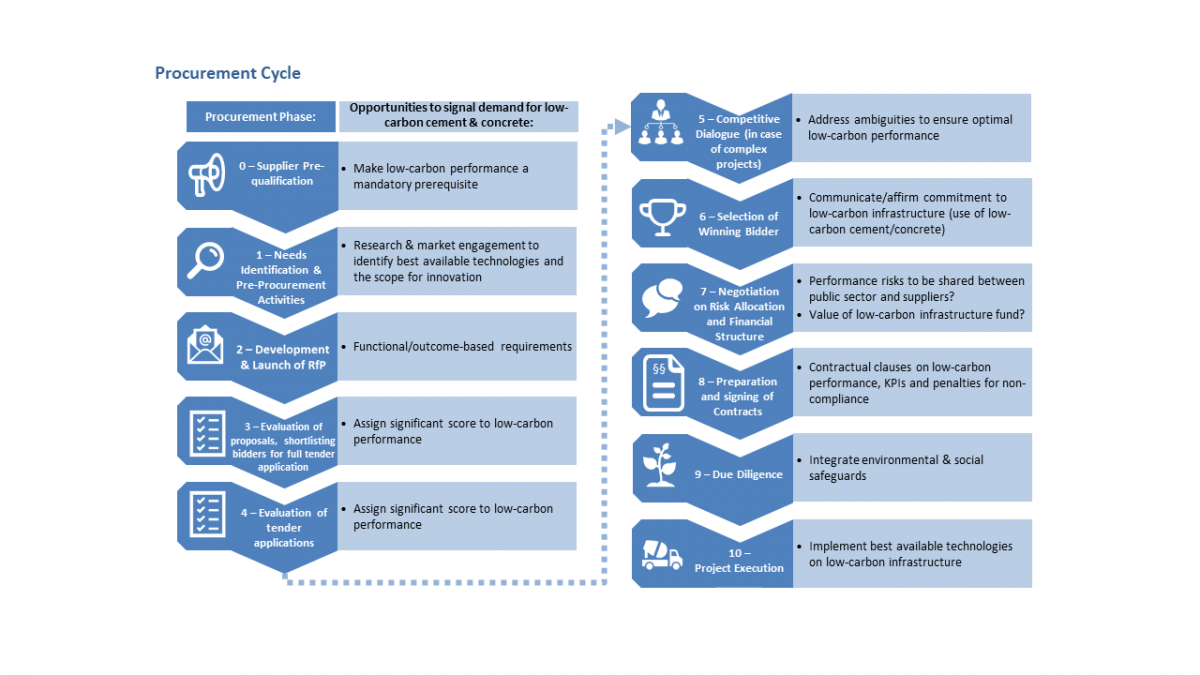Public Procurement and Innovation for Low-Carbon Infrastructure
Cement is responsible for 5 per cent of anthropogenic carbon dioxide emissions. IISD and the Industrial Innovation for Competitiveness initiative (i24c) are investigating how public procurement can drive markets for low-carbon solutions and innovation in Europe. We are focused on low-carbon and circular economy construction materials and how they can ultimately contribute to a shift towards low-carbon infrastructure.
The purchasing power of the public purse has the potential to support Europe’s low-carbon industrial development. Today, public procurement represents around 14 per cent of the European Union's GDP. Public procurement of infrastructure in Europe accounts for approximately 22 per cent of the construction sector's output, and continuous growth is expected in most infrastructure areas. Given the importance of cement and concrete for infrastructure projects (and the sector's significant emissions),1 public procurement constitutes a high-impact policy arena for achieving deep decarbonization and more circular practices in these sectors. It thus can create lead markets in Europe for low-carbon cement and concrete products, as well as other low-carbon building materials. Although it features as an important element of the European Commission's Single Market Strategy, public procurement is currently underused as a policy instrument to drive low-carbon innovation.
The research project collected best practices of public procurement laws, processes and strategies that are currently deployed to drive low-carbon innovation in the construction and infrastructure sector. It identified the challenges and opportunities and ultimately resulted in strategic recommendations for public procurement agencies, European Union policy-makers and member states on how to better position public procurement as a strategic driver of low-carbon development in Europe. The result of the research is published in the report and policy brief below.
From January until December 2017 we undertook desk research, participated in several round table events and conducted in-depth semi-structured interviews with industry, national and local procurement agencies and innovation brokers. All interviews indicate that there is strong potential for public procurement to increase low-carbon innovation in the infrastructure and construction value chain. The research also provided concrete examples of how to do so in various stages of the public procurement cycle. The research also underlines that there is no silver bullet. Innovation can be triggered at various stages of the procurement cycle, as illustrated by the figure below. Depending on the project, certain stages of the procurement cycle will be more suitable and powerful than others to drive innovation and circularity in the building materials sector.

In June 2017 we convened an expert meeting in Brussels that focused on effective measures to link public procurement and low-carbon development in the construction industry. The meeting validated most of our research findings and provided further input for strategic recommendations from all relevant stakeholders (industry, public procurers, policy-makers, investors, experts).
A policy brief was circulated in December 2017 and a final report was published in February 2018.
WHAT IS LOW-CARBON CEMENT?
- Cements with low clinker content based on the use of supplementary cementitious materials (e.g., fly ash, slag, pozzolana, limestone).
- Innovative materials, material compositions or processes that reduce the embodied carbon content (e.g., mechanical treatment, lower temperature requirements, utilization of recycled materials).
- High-performance cements with positive carbon impact in subsequent life-cycle stages (e.g., lower amounts of cement for same performance of concrete, carbon absorption properties, improved recyclability).
Other work by IISD on energy-intensive industries:
- Energy-Intensive Industries: Decision making for a low-carbon future - The Case of Cement
- Energy-Intensive Industries: Decision making for a low-carbon future - The Case of Steel
About IISD and its expertise on public procurement and infrastructure finance
IISD is observer to the OECD Leading Practitioners on Public Procurement Working Group, Member of the G20/B20 Finance and Inclusive Growth Task Force, the G20 Sherpa’s advisory group on infrastructure, the Global Environment Facility Technical Advisory Group on Green Infrastructure and Green Finance, and the GGKP Green Growth and the Law Research Committee. IISD is currently undertaking similar research to advise the Government of Canada on public procurement strategies for low-carbon infrastructure. It is also working with the government of the Western Cape Province in South Africa on performance-based procurement to implement their Green Economy Strategy.
About i24c
 Launched in 2015, i24c is the European Climate Foundation's platform dedicated to developing and promoting an industrial strategy that secures the European industry's competitive advantage through innovation. The initiative communicates an evidence-based narrative to inform the critical debate on industrial policy. The approach of i24c is twofold: it focuses on the extent to which Europe and member states can define industrial strategies that would in turn help Europe into an "Entrepreneurial Union" capable of leading the world and stimulating purposeful innovation to meet "grand challenges." It undertakes holistic value-chain analyses to identify innovation and competitiveness potentials along the complete value chain.
Launched in 2015, i24c is the European Climate Foundation's platform dedicated to developing and promoting an industrial strategy that secures the European industry's competitive advantage through innovation. The initiative communicates an evidence-based narrative to inform the critical debate on industrial policy. The approach of i24c is twofold: it focuses on the extent to which Europe and member states can define industrial strategies that would in turn help Europe into an "Entrepreneurial Union" capable of leading the world and stimulating purposeful innovation to meet "grand challenges." It undertakes holistic value-chain analyses to identify innovation and competitiveness potentials along the complete value chain.
I24c’s work is guided by a High-Level Group of leading policy-makers, industrialists and thought leaders. The members of the High-Level Group act as ambassadors of i24c’s work and provide a platform to test and check the work of the initiative, which takes place three times a year at the i24c High-Level Group meetings.
[1] The cement sector’s global emissions account today for approximately 5 per cent of anthropogenic carbon dioxide emissions. Source: European Cement Association (CEMBUREAU). (2013). The role of cement in the 2050 low carbon economy. Retrieved from http://lowcarboneconomy.cembureau.eu/uploads/Modules/MCMedias/1380546575335/cembureau---full-report.pdf
Latest
You might also be interested in
The Sustainable Asset Valuation (SAVi)
IISD developed the Sustainable Asset Valuation (SAVi) to demonstrate to governments, investors and citizens why sustainable assets can deliver better value for money and more attractive internal rates of return.
Accelerating Decarbonization Through the Power of Procurement
This project supports the dissemination of the CO2 Performance Ladder, a tool for low-carbon procurement and carbon management. Widespread green public procurement with the CO2 Performance Ladder can speed up the decarbonization of companies, projects, and supply chains and help governments meet their climate commitments.
Task Force for a Resilient Recovery
With ideas from Canada and around the world, our Task Force aims for a resilient recovery—one that delivers good jobs, is positive for the environment, and addresses inequality.
China Council for International Cooperation on Environment and Development - CCICED
The China Council for International Cooperation on Environment and Development (CCICED) was founded in 1992.

